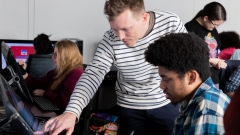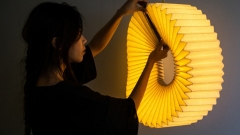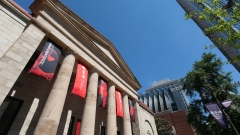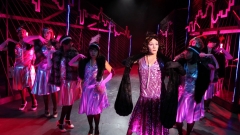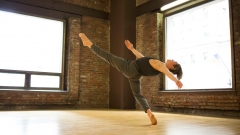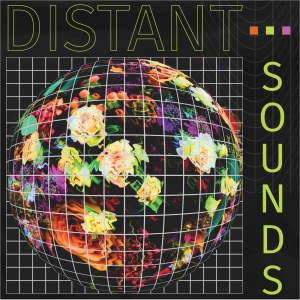Creativity is Home: Alum William Felinski
May 4, 2020
Distant Sounds: Collective Participatory Sound Artwork in the Time of COVID–19, the current project by William Felinski MDes ’19 (Product Design), explores several questions: “What does it mean to create right now—to be physical versus digital? At what point now does the object or action become art if we’re just in our homes?” and most importantly, “What does self-isolation sound like?” UArts caught up with Felinksi via Zoom to hear about his inspiration, research and goals for the project.
Felinski identifies as a hybrid artist, which gives him the freedom to engage with any material. But without access to his studio and typical media, Felinski has decided to explore something new: sound. “I thought about how I could use [another] platform to still make art with other people. So I’m thinking of everyone’s location [while] practicing stay-at-home as their studio.” Felinski typically works on site at Olio Projects, a curatorial collective he created to break walls between existing art organizations and bring members together to experience something new.
For Distant Sounds, Felinski established an open call for submissions from artists all over the world: a 30-second recording of ambient sound in their living space and a brief written reflection. He plans to create a time capsule–esque soundscape of the global freeze. “It’s a good time for artists to not worry about how they can work like they [would normally] work,” he said. “It’s [time] to question what [they] can do right now and try new things—to work in [media] that they maybe haven’t explored before. As cheesy as it is, constraints breed creativity.”
In the first week of quarantine, Felinski was simply searching for inspiration. “I started recording myself boiling pasta, and then I would try to write a multimedia piece: ‘214 degrees, penne.’” But the idea for Distant Sounds actually came from the sound of birds he recorded for a friend. He thought, “If everyone was doing this, what would that be like?” Born of reflective meditation, this spark was fueled by his research of pirate radios and desire to support fellow artists.
“In my own practice, I’m connecting to the quiet meditation moments several artists have had that later influenced the way they work,” said Felinski, referring to sound artist William Basinski. “During 9/11 … he created a piece called The Disintegration Loops,” an album of found sounds which became the soundtrack of the aftermath. Basinski completed the project the morning of the World Trade Center attacks, which he filmed from his Brooklyn rooftop. “It’s not a complete parallel but … what if this is [our] moment, and what is the sound of everyone’s experience?” Felinski wondered.
Armed with the idea and another looming question, “What do I do today?” Felinski decided to make a pirate radio. “I like the idea of an invisible public work,” he said, noting that radio signals are public domain. “But pirate radio has this history of being illegal. People would go off the coast and blast frequencies.” Felinski plans to make or buy an FM transmitter to broadcast the collective sound sculpture on a loop and hopes to assemble 24 hours of ambient sound, leaving the project open-ended for the duration of the pandemic. “I think it’s a really great opportunity for every artist to take a deep breath and not have to go to an opening to make sure they’re doing the social part of the game … to not engage so deeply on social media. I want people to take a break from their screen and just listen to this thing; to just be with yourself.”
In true pirate spirit, Felinski also sees Distant Sounds as an opportunity for artists who haven’t yet “broken into” the art world. He was inspired by a group called Occupy Museums (like Occupy Wall Street). “They had an open call, [for which] you submitted five images, wrote some answers to their questions and they created an interactive website, where every artist was projected at the [Whitney] Biennial in 2017. They used this museum platform to showcase a large group of people and [give them] a really nice CV line.”
“The art world is known for being very exclusive, selective and nepotistic, in my opinion,” Felinski said. “You have this whole group of artists who are indebted to the same institutions that are investing at the very top of the field. So I’m combining with a group of artists to enter into a museum context.” Felinski pointed out that many institutions are exhibiting online but remain just as exclusive. He’s using his background in sculpture, fine art and arts administration to propel the project, employing marketing skills, artist theory and design practice to give other artists an exhibition space in a time when physical spaces are closed.
Felinski completed his Master of Design degree at UArts just last year. He concentrated in biofabrication, design strategy and sustainable material applications. “I ultimately believe the job of a designer is to communicate.” He sees his role as an artist much differently. “I won’t find answers, as a designer typically does. I will raise questions and leave it at that. I don’t think it’s important that I necessarily tell you why this exists or what it means. I just want to see what happens if we do it and what people’s reactions will be.”
Distant Sounds has received over 70 submissions from 10 countries, including an early and surprising submission from Indonesia—birds that sound like howler monkeys. “This is a very unique moment—to think that there’s this thing that we ‘can’t see’ but it has created [physical] change, not just behavioral. One thing I’m really excited about is, I received submissions where people have [been] clapping for service workers and first responders in New York, which I think is remarkable,” said Felinski. “That’s the Basinski moment—the cultural unity within isolation.”
To learn more about Distant Sounds and submission guidelines, visit https://olio.gallery/distant-sounds.
Explore Product Design at UArts.

